25 least expensive states to live in
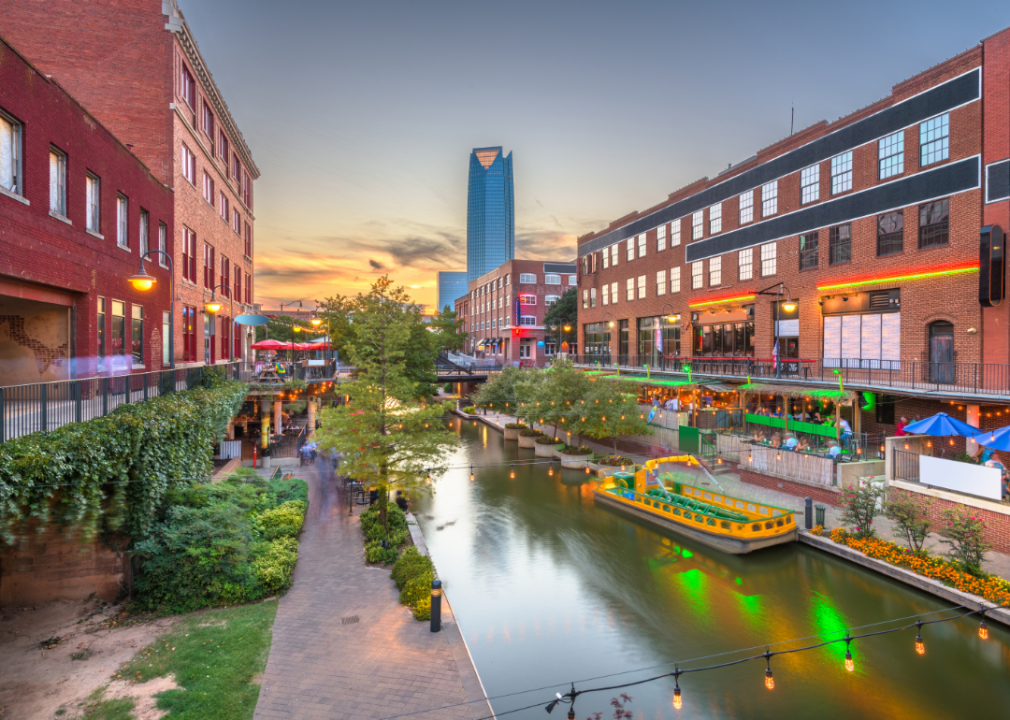
Canva
25 least expensive states to live in
The neighborhood of Bricktown in Oklahoma City, Oklahoma.
Over the last three decades, the rising cost of living has been weighing on Americans. The situation became even more dire in the wake of the COVID-19 pandemic. Record-setting inflation rates in 2022 and stagnating or falling salaries during the same period have burdened U.S. residents. The size of the middle class shrunk by 10 percentage points between 1971 and 2023, while lower-income American households grew from 27% to 30%, according to Pew Research.
An unaffordable housing market coupled with soaring childcare prices has left many young families feeling like they can’t meet their goals, CNN reports. Similarly, a 2024 Pew Research survey found that 41% of respondents felt the American dream was once possible, but not anymore.
A key factor in how much you make and spend and how possible that American dream is can come down to where you live. To identify the most affordable states, Stacker used data from the Council for Community and Economic Research (C2ER) to determine the 25 states with the lowest cost of living as of August 2024. Each state’s cost of living index was calculated based on the prices of 60 goods and services from a voluntary survey. Figures were rounded to the nearest 10th of a percent.
Every index is a percentage of the U.S. average. For example, a state with an index of 90 has a cost of living 10% lower than the national average.
Read on to see if your state is one of the most affordable in the country.
You may also like: The 10 best industries to start a business in 2023
![]()
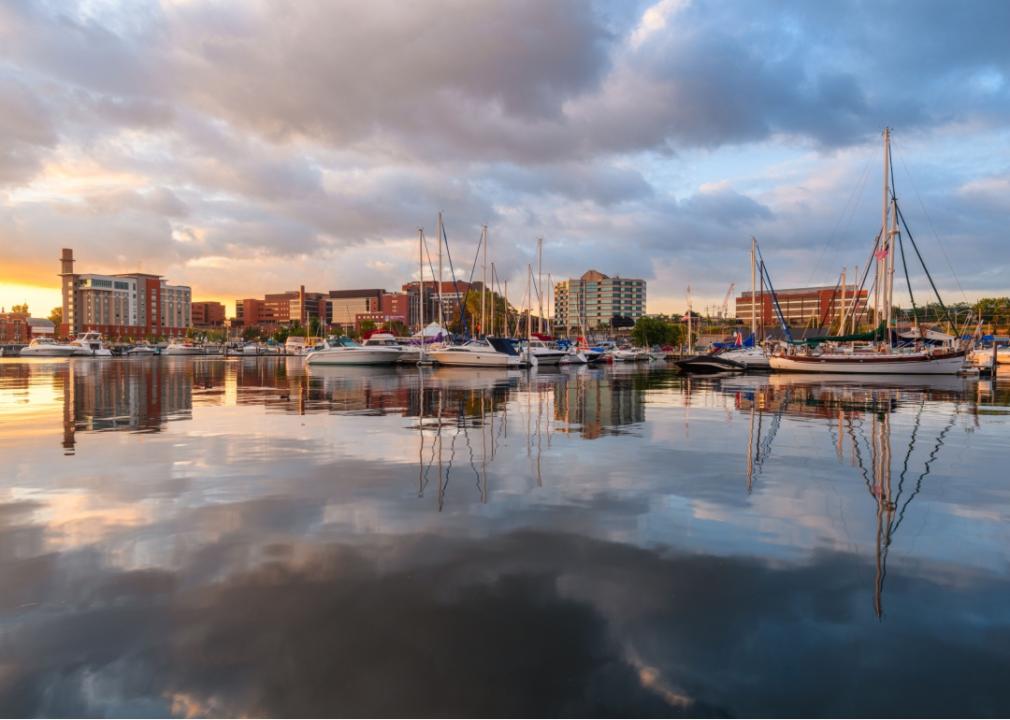
Sean Pavone // Shutterstock
#25. Pennsylvania
Sunset over a harbor filled with sailboats. The city skyline is visible in the distance.
– Average cost of living index: 95.6
— Groceries: 98.4
— Health care: 88.4
— Housing: 85.8
— Transportation: 107.5
— Utilities: 103.5
— Other: 97.8
Pennsylvania snuck onto this list with the third-lowest health care costs of any state in the U.S., according to C2ER. Transportation and utilities may be relatively expensive, but miscellaneous expenditures are not, including getting a haircut, seeing a movie, and dropping in on a yoga class, per the C2ER report.
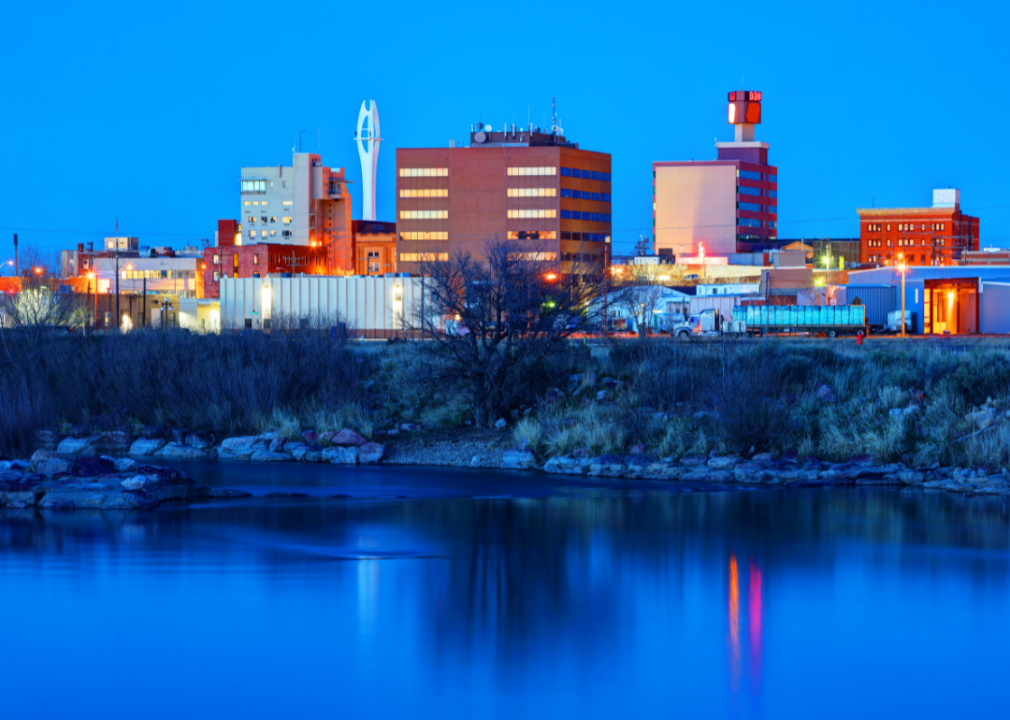
Canva
#24. Wyoming
Buildings in Casper, Wyoming, as seen at night.
– Average cost of living index: 95.1
— Groceries: 100.4
— Health care: 105.9
— Housing: 87.6
— Transportation: 88.5
— Utilities: 85.5
— Other: 102.1
Wyoming has no personal or corporate income tax, which makes it the most business-friendly locale in the nation, along with South Dakota, according to the Tax Foundation. The Cowboy State also produces an abundance of coal, leading to utility costs that are 14.5% lower than the national average.
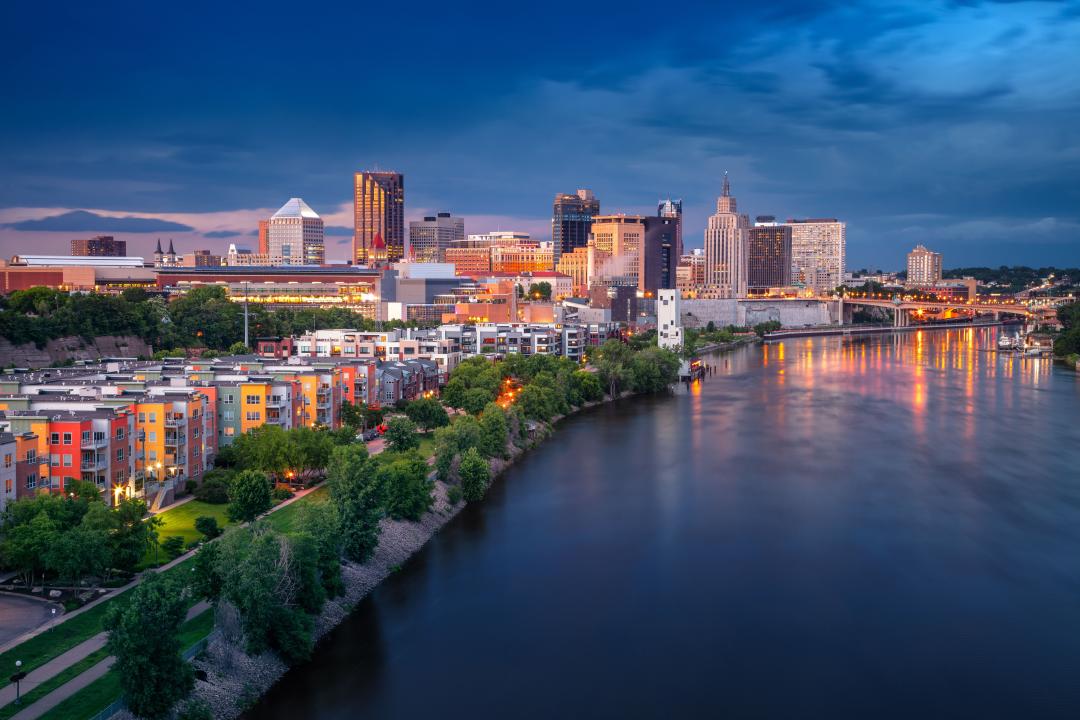
Rudy Balasko // Shutterstock
#23. Minnesota
City’s skyline with numerous illuminated buildings and skyscrapers.
– Average cost of living index: 94.8
— Groceries: 102.3
— Health care: 106.3
— Housing: 81.5
— Transportation: 94.2
— Utilities: 96.7
— Other: 100.8
Minnesota is particularly affordable when it comes to housing. Though the median mortgage of $1,818 is no walk in the park, 72.3% of the state’s homes are owned, according to the Census Bureau. Two new housing aid programs also launched in 2023 and 2024 that will provide funding to counties, metros, and Tribal Nations to help develop and preserve affordable housing.
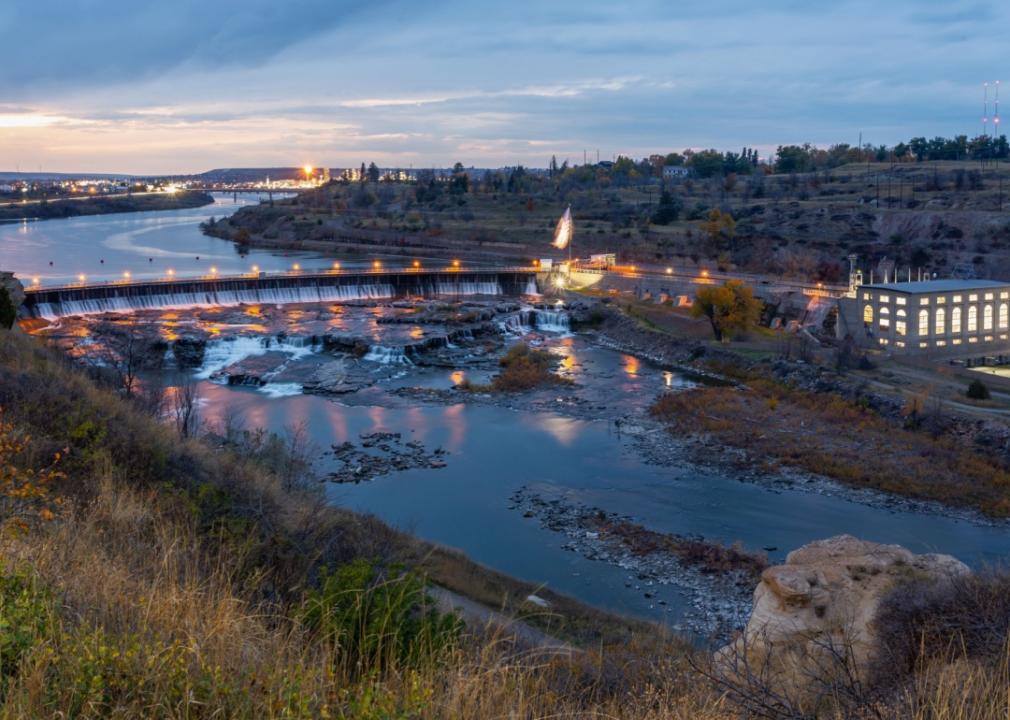
Victoria Ditkovsky // Shutterstock
#22. Montana
Dam and its surroundings at night with wide river reflecting the lights.
– Average cost of living index: 94.6
— Groceries: 99.7
— Health care: 108.9
— Housing: 84.8
— Transportation: 107.5
— Utilities: 83.9
— Other: 97.1
Big Sky Country is a top spot for renewable energy, which helped it land among the 25 least expensive states to live in. Montana has the eighth-highest share of electricity generated from renewable resources (51%) nationwide, according to Yale Climate Connections.
The state also has the third-lowest natural gas prices in the country, per the Energy Information Administration, which contributes to its utilities costing 16% lower than the national average.
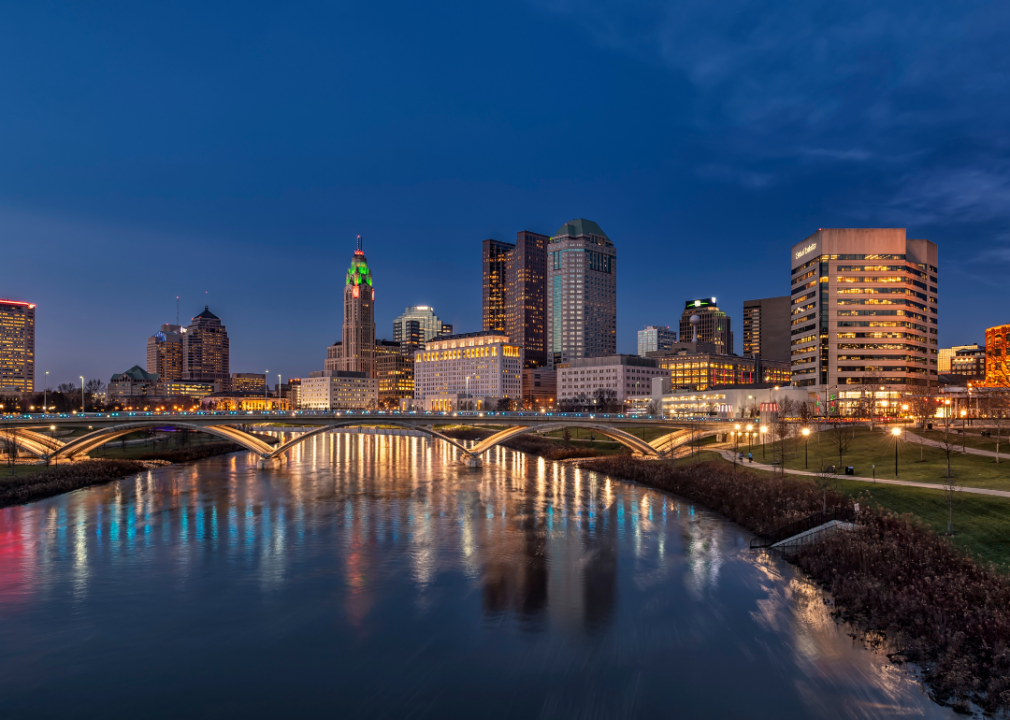
Canva
#21. Ohio
The river leading into Columbus, Ohio, at night.
– Average cost of living index: 94
— Groceries: 99.1
— Health care: 94.6
— Housing: 84
— Transportation: 96.2
— Utilities: 101.8
— Other: 97.4
Ohioans can thank affordable housing for their low cost of living—it’s 16% lower than the national average. However, while the median mortgage in the state is nearly 25% below the U.S. average, rents haven’t seen the same trajectory.
A 2024 report from the National Low Income Housing Coalition and the Coalition on Homelessness and Housing in Ohio found that full-time workers need to earn at least $20.81 per hour to afford the rent of a two-bedroom apartment in Ohio and only two of the state’s most common jobs reach that pay scale.
You may also like: 15 funding options to start a new small business
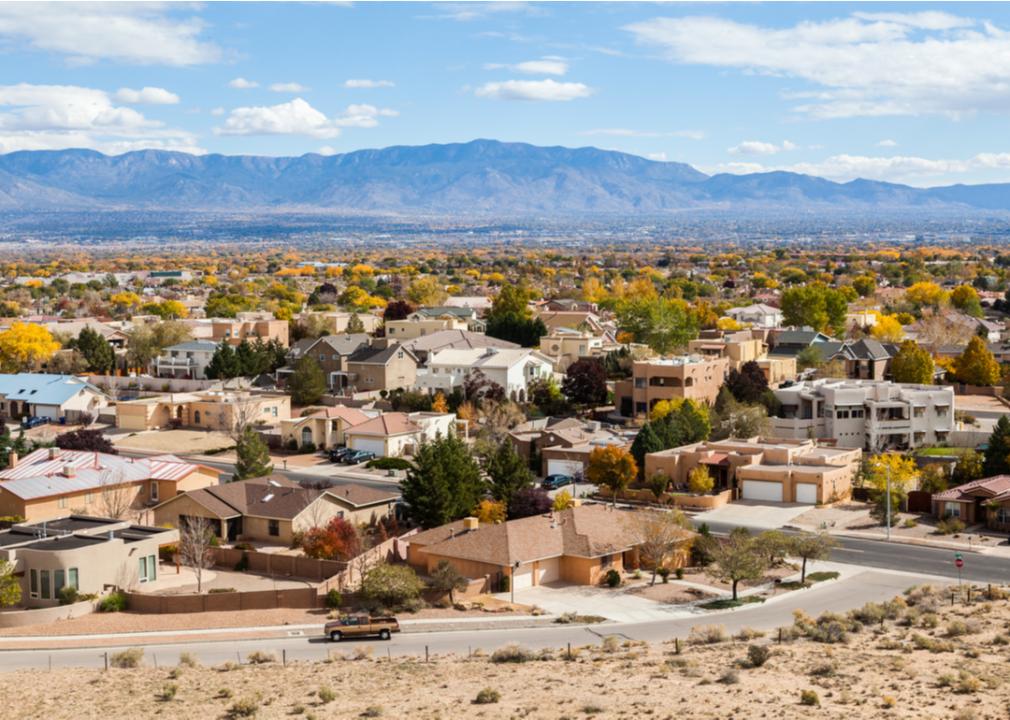
turtix // Shutterstock
#20. New Mexico
Residential suburbs in Albuquerque, New Mexico.
– Average cost of living index: 93.6
— Groceries: 95.8
— Health care: 101
— Housing: 88.1
— Transportation: 92.5
— Utilities: 86.5
— Other: 98.4
New Mexico residents’ utility bills are among the lowest, ranking at #7 nationwide. The state is a major oil and natural gas producer as well as a wind power leader, producing 38% of its electricity that way in 2023, per the EIA. The state also ranks at #1 when it comes to property taxes, according to the Tax Foundation.
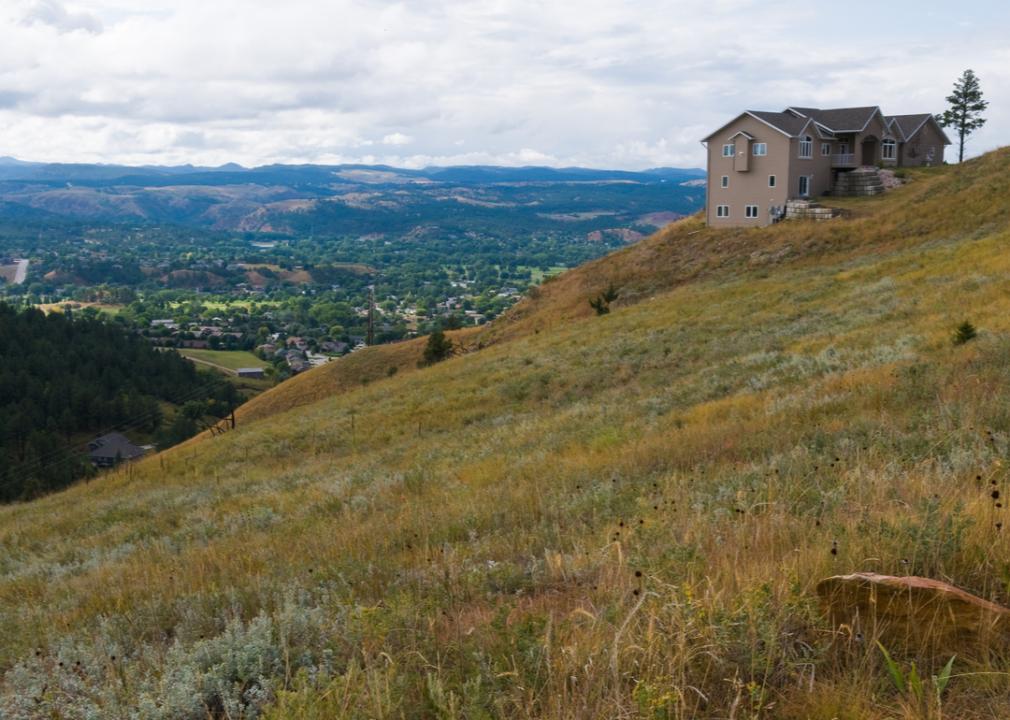
Hank Shiffman // Shutterstock
#18. South Dakota (tie)
The western suburbs of Rapid City, South Dakota.
– Average cost of living index: 93.4
— Groceries: 97.6
— Health care: 102
— Housing: 88.1
— Transportation: 102.5
— Utilities: 85.6
— Other: 94
South Dakota stands out for its affordable utilities and miscellaneous expenses, including the cost of necessities like major appliance repairs and toiletries like toothpaste and shampoo. The state does not have an individual or corporate income tax, and natural gas and electricity prices are also much lower than the national average, according to the EIA.

Canva
#18. Nebraska (tie)
Train tracks as seen outside Omaha, Nebraska, at night.
– Average cost of living index: 93.4
— Groceries: 98.2
— Health care: 102.4
— Housing: 80.7
— Transportation: 96.1
— Utilities: 90.5
— Other: 100.8
Nebraska is the only state that generates electricity solely from publicly owned power systems. As a result, energy costs are much lower than they are in other states in the nation. Nebraska is also home to the relatively affordable cost of living—19% below the national average—thanks, in part, to its investments in more than a dozen housing programs.
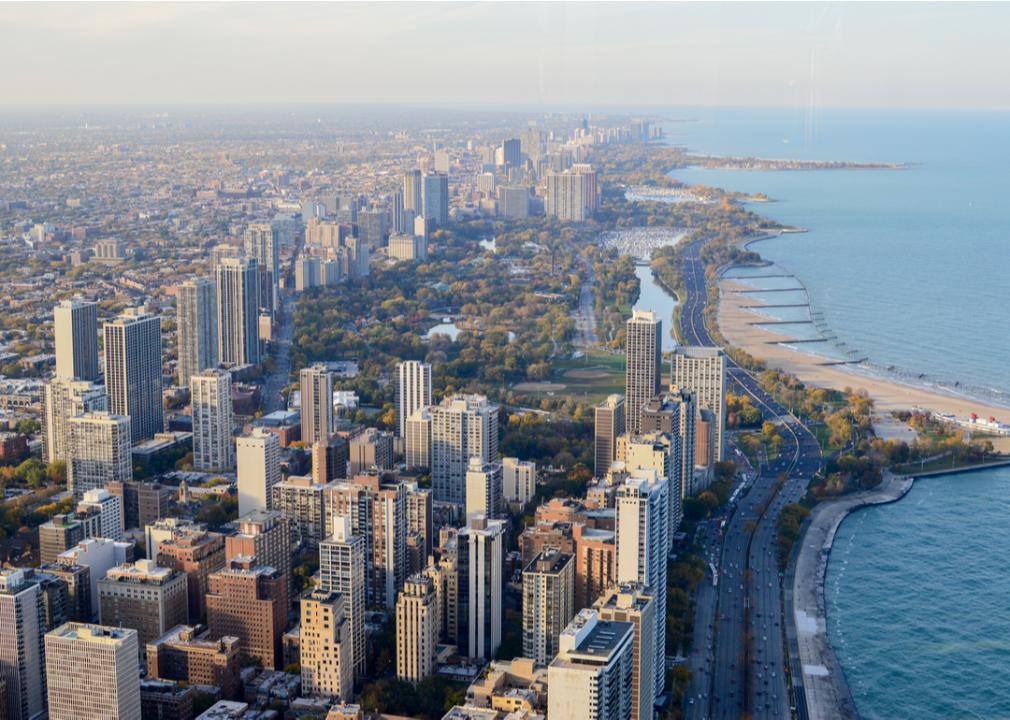
DiegoMariottini // Shutterstock
#17. Illinois
Skyscrapers and Lake Michigan in Chicago.
– Average cost of living index: 93.3
— Groceries: 97.7
— Health care: 99.9
— Housing: 82.2
— Transportation: 97.5
— Utilities: 98
— Other: 97.1
More than 1 in 5 Illinois residents live in Chicago, the third-most populous city in the United States. Still, the higher cost of living in the Windy City doesn’t keep Illinois from being relatively inexpensive. Home prices, at nearly 18% cheaper than the national average, are the biggest bonus.
However, according to an analysis from the Illinois Policy Institute of Census Bureau data, the state has more residents who are housing burdened (meaning housing costs more than 30% of the household’s income) than any of the other 12 Midwestern states. More than 33% of Illinois households are housing burdened and nearly 16% are severely burdened (i.e., more than 50% of their income goes to housing).

Canva
#16. North Dakota
Buildings in Fargo, North Dakota, as seen at night.
– Average cost of living index: 92.8
— Groceries: 94.5
— Health care: 109.3
— Housing: 82.2
— Transportation: 98.7
— Utilities: 83.4
— Other: 99.3
North Dakota has a wealth of job opportunities, sporting the second-lowest unemployment rate nationwide as well as low income tax rates, making it one of the most affordable places to live in the Midwest.
It’s also the least expensive state for groceries in the country, with the city of Grand Forks specifically coming in as the most affordable place for groceries nationwide, according to C2ER. Housing is also on the less costly side, and the state has one of the lowest housing-burdened rates in the Midwest.
You may also like: Which countries own the most gold?
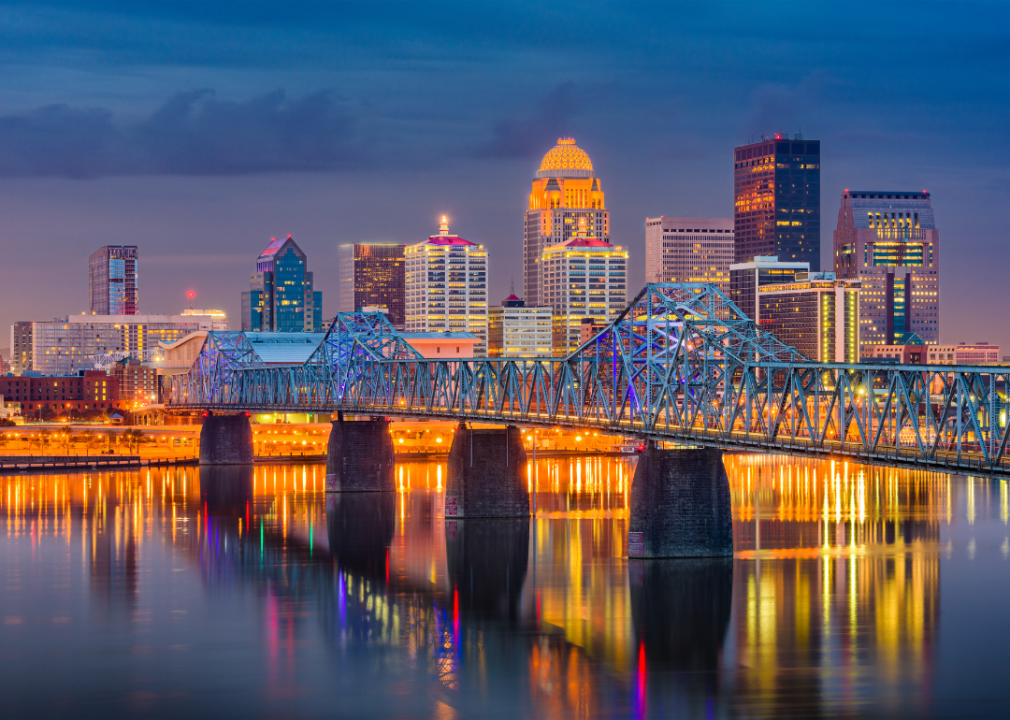
Canva
#15. Kentucky
Downtown Louisville, Kentucky, as seen at night.
– Average cost of living index: 92.6
— Groceries: 99.7
— Health care: 106.8
— Housing: 78.2
— Transportation: 95.1
— Utilities: 87.1
— Other: 100.3
According to AAA’s national gas prices index, Kentuckians pay on the low end of the spectrum. They also benefit from the third-lowest electricity prices east of the Mississippi River, according to the EIA. Housing is nearly 22% lower than the national average, but Louisville has been on the cusp of a housing crisis that both lawmakers and residents have been trying to solve for years.

Roschetzky Photography // Shutterstock
#14. Texas
An aerial view of Austin, Texas, and Lady Bird Lake.
– Average cost of living index: 92.4
— Groceries: 96.2
— Health care: 96.1
— Housing: 82.1
— Transportation: 92.7
— Utilities: 103.6
— Other: 96
Texas does not have an income tax, and its housing is extremely affordable for such a populous state (only California has more residents). The median home price and mortgage payment in the Lone Star State are $238,000 and $1,913, respectively, per the Census Bureau. Transportation costs come in #12 in the U.S., thanks to Texas’ standing as an oil and gas giant.
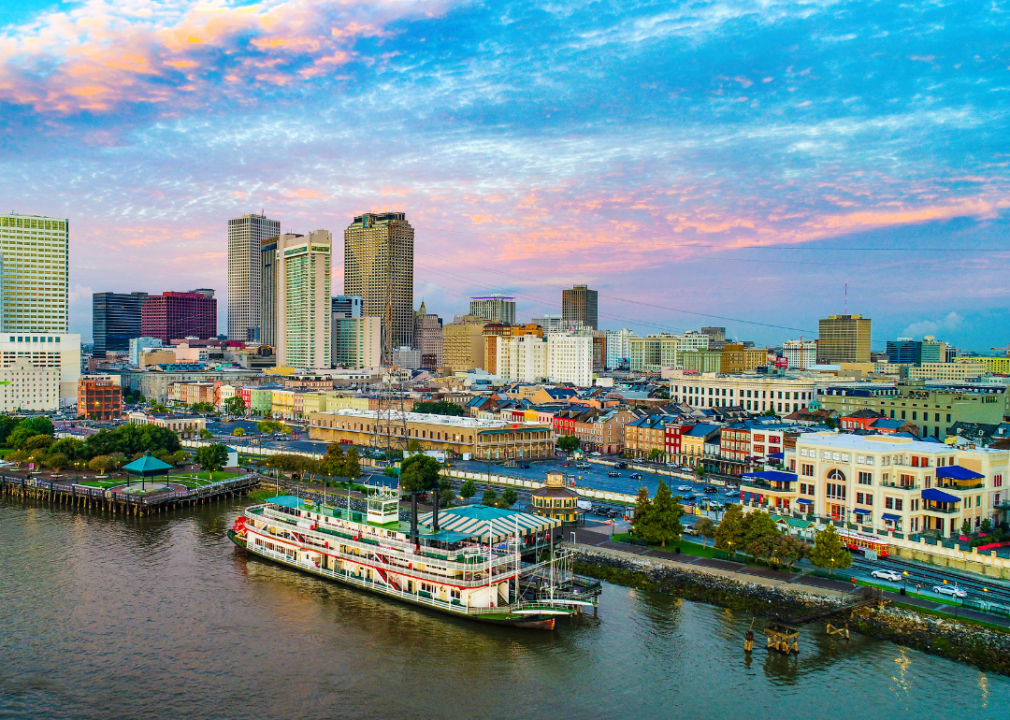
Canva
#13. Louisiana
New Orleans near the water at dusk.
– Average cost of living index: 92.1
— Groceries: 95.8
— Health care: 94.5
— Housing: 84.6
— Transportation: 95.4
— Utilities: 79.7
— Other: 98.8
Louisiana is particularly affordable in terms of utility costs and groceries, ranking #2 for the former and #6 for the latter, according to C2ER’s data. The Bayou State has the second-highest oil refinery capacity in the country and is also the third-biggest natural gas producer nationwide, according to the EIA.
Housing costs are more than 15% lower than the national average, though living in New Orleans costs 23% more than the state average.
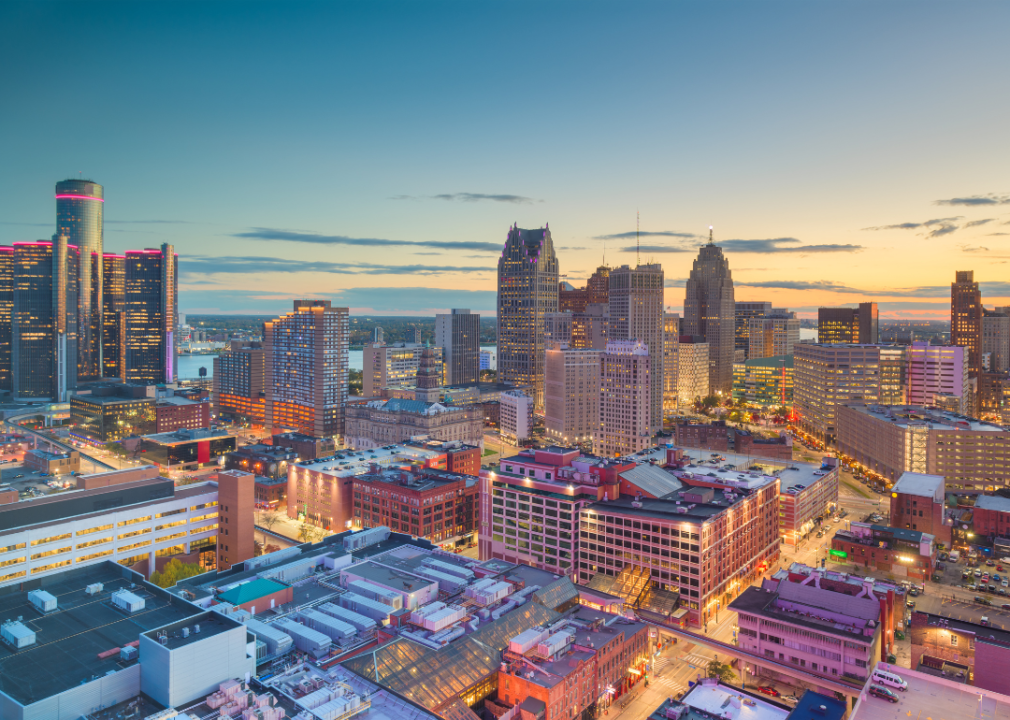
Canva
#12. Michigan
An aerial view of downtown Deroit at dusk.
– Average cost of living index: 91.8
— Groceries: 98.3
— Health care: 90.9
— Housing: 77
— Transportation: 98.3
— Utilities: 97
— Other: 98
Housing costs are low in Michigan, and two of its cities—Detroit and Grand Rapids—ranked among the 20 least expensive housing markets in the world in a 2024 International Housing Affordability report from the Center for Demographics and Policy at Chapman University in California. Health care costs are also lower than those in all but seven states in the U.S.

ESB Professional // Shutterstock
#11. Georgia
A view of Atlanta’s skyline from Lake Meer in Piedmont Park.
– Average cost of living index: 91.3
— Groceries: 97.7
— Health care: 99.9
— Housing: 79.7
— Transportation: 97.7
— Utilities: 94
— Other: 94.4
Georgia’s housing costs are its greatest affordable living selling point. In recent years, the median home value was $245,900, and those with mortgages paid $1,640 per month, while renters spent $1,221, according to the Census Bureau. Georgia locales consistently rank as some of the least expensive in the country.
Augusta, for example, landed at #8 on Zillow’s ranking of the most affordable places to buy a home in 2024 and earned the same spot on Kiplinger’s list of the cheapest cities to live in 2024.
You may also like: Malls are closing across the country. These states are keeping them alive.
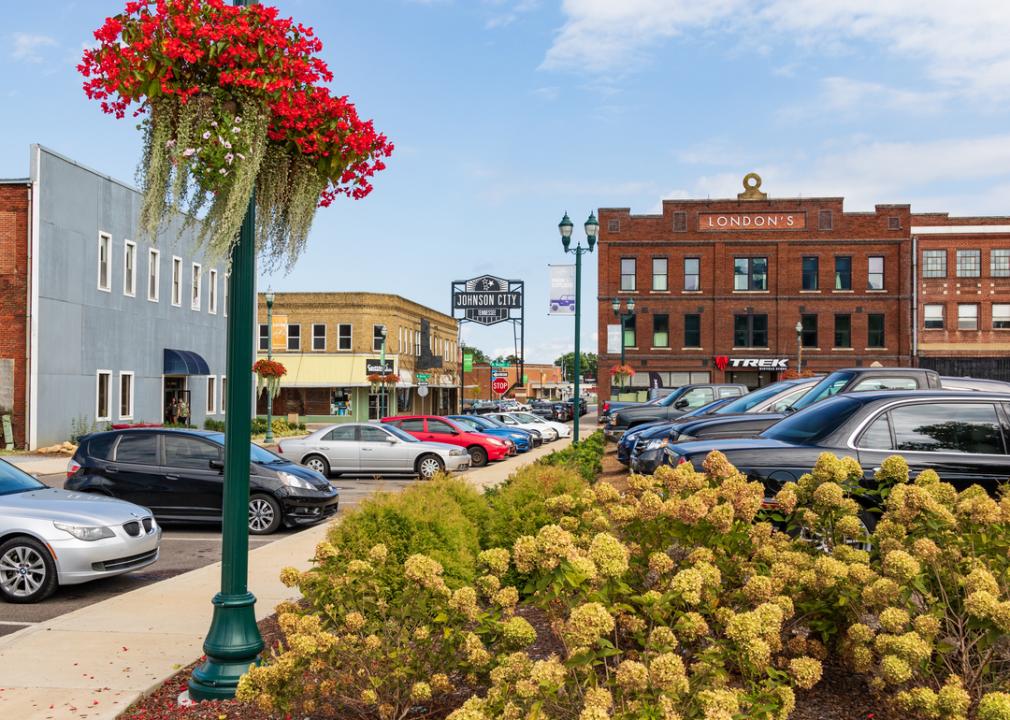
Nolichuckyjake // Shutterstock
#9. Tennessee (tie)
Cars parked along the street in Johnson City, Tennessee.
– Average cost of living index: 90.3
— Groceries: 97.1
— Health care: 90.2
— Housing: 82.8
— Transportation: 89.1
— Utilities: 88.6
— Other: 94.5
In health care and transportation expenses, Tennessee ranks #4 and #5 nationwide. The Volunteer State also pays the fourth-lowest rate for natural gas in the country, according to the EIA, and ranks 12th in electricity costs. Tennessee has no personal income tax and effective property tax rates (0.48%), per the Tax Foundation. The state also has a low unemployment rate of 3%.
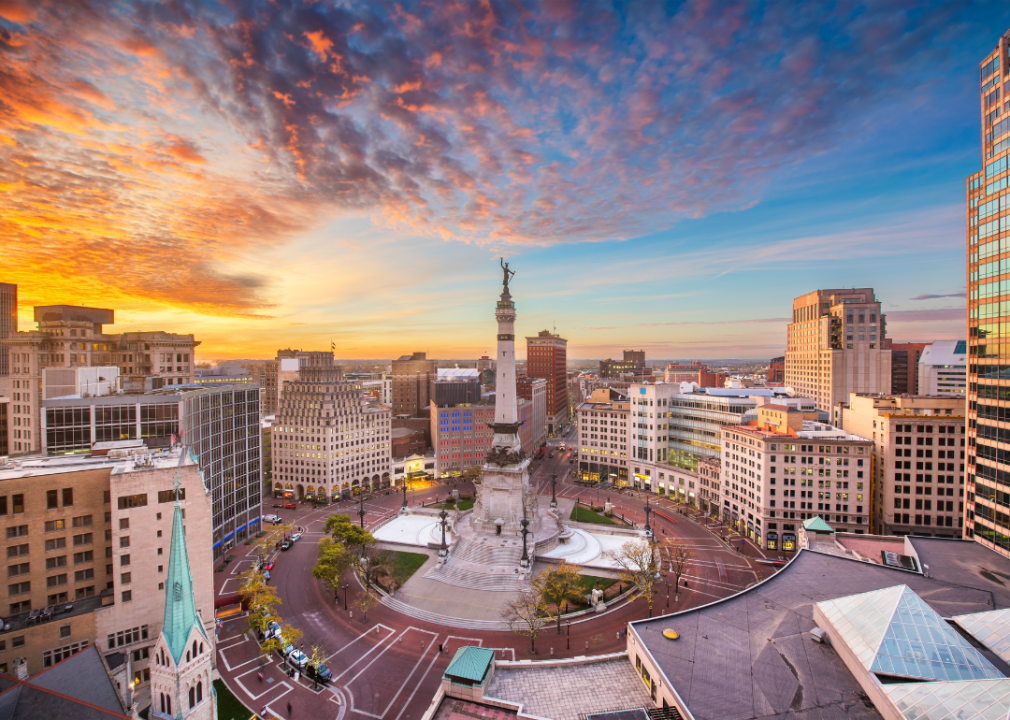
Canva
#9. Indiana (tie)
An aerial view of Indianapolis at sunset.
– Average cost of living index: 90.3
— Groceries: 97.6
— Health care: 97.3
— Housing: 77.8
— Transportation: 94.8
— Utilities: 90.4
— Other: 95.1
Indiana’s housing market is one of the 10 most affordable nationwide. More than 70% of occupied homes were owned from 2018 to 2022, according to the Census Bureau. The median home value was $183,600 with a $1,301 mortgage payment, while renters spent $967 on average every month.
The Hoosier State also enjoys one of the lowest individual income tax rates in the country at 3.05% as of 2024. A new bill that went into effect on Jan. 1, 2024, will lead to further reductions annually: 3% in 2025, 2.95% in 2026, and bottoming out at 2.9% in 2027.
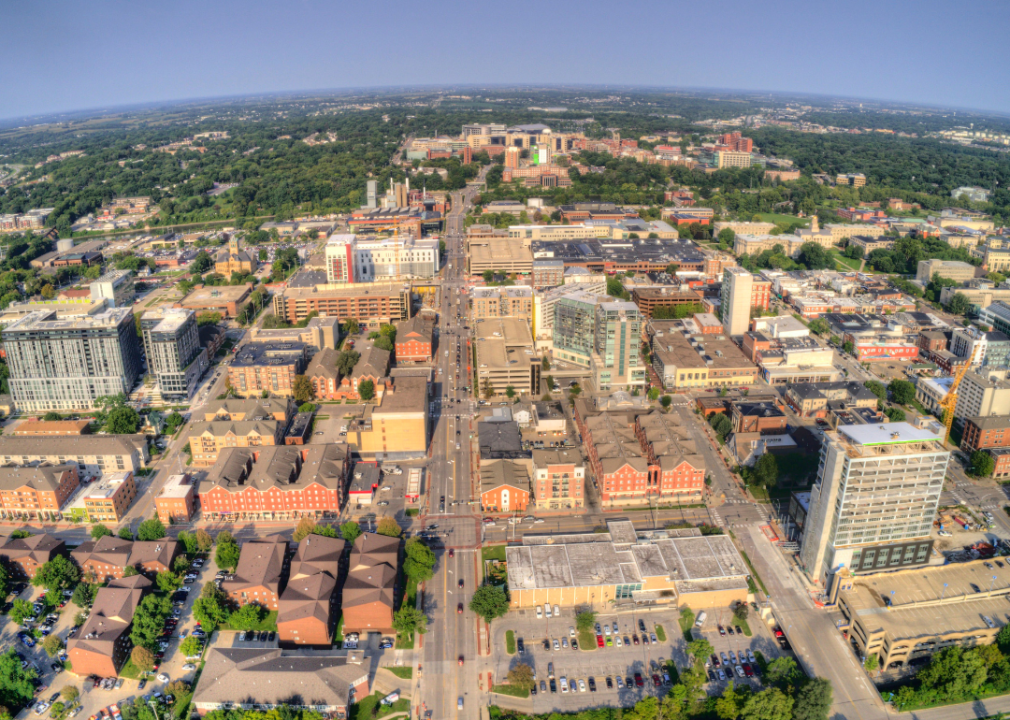
Canva
#8. Iowa
An aerial view of Iowa City, Iowa, on a sunny day.
– Average cost of living index: 90.1
— Groceries: 96.7
— Health care: 96.3
— Housing: 75.1
— Transportation: 96.9
— Utilities: 93.5
— Other: 95.7
Iowa’s housing market is the sixth most affordable in the U.S., with a median home value of $181,600 and 71.5% home ownership, according to the Census Bureau. Job opportunities abound in advanced manufacturing, bioscience, finance, and insurance. To boot, the state’s unemployment rate (2.8%) is the seventh-lowest in the country, per the Bureau of Labor Statistics.
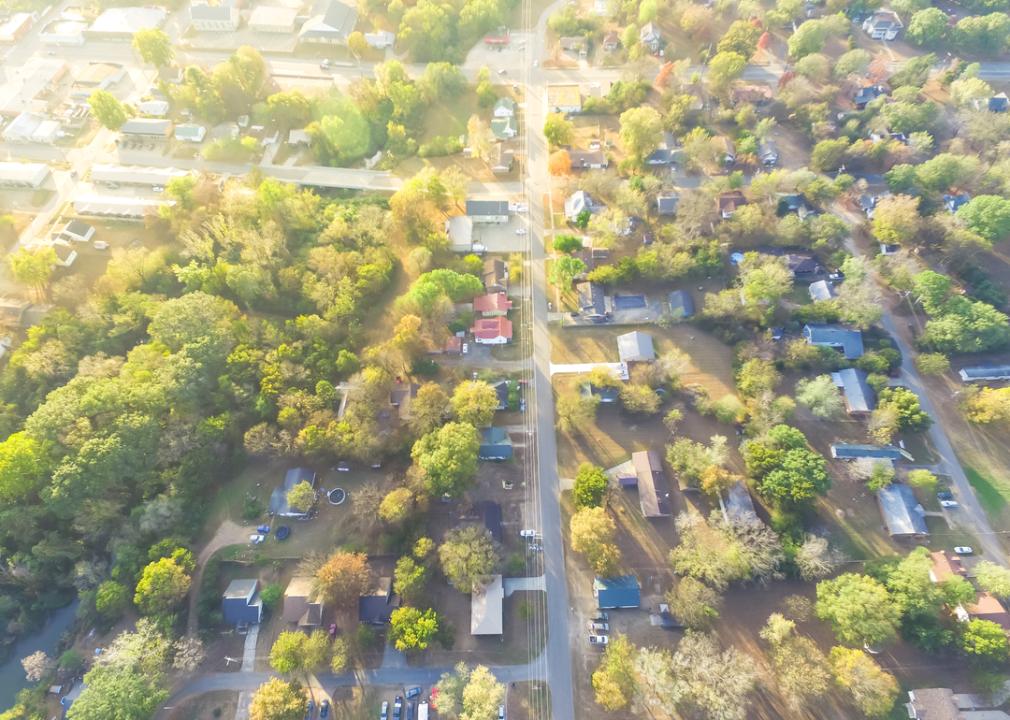
Trong Nguyen // Shutterstock
#6. Missouri (tie)
A scenic suburb in Ozark, Arkansas.
– Average cost of living index: 88.5
— Groceries: 95.5
— Health care: 91.2
— Housing: 77.7
— Transportation: 84
— Utilities: 98.5
— Other: 93
Missouri boasts diverse career opportunities, and housing costs 22% below the national average. It also has the lowest transportation costs in the country, is #4 in grocery costs, and is #6 in miscellaneous expenditures, according to the C2ER report.
Smaller cities like Springfield and Joplin are particularly low cost, compared to larger cities like St. Louis and Kansas City. Still, the latter two metros found themselves among the top 20 most affordable housing markets in the world in the aforementioned 2024 Chapman University report.

Paul Brady Photography // Shutterstock
#6. Arkansas (tie)
The St. Louis Gateway Arch in Missouri.
– Average cost of living index: 88.5
— Groceries: 95
— Health care: 88.2
— Housing: 74.9
— Transportation: 88.2
— Utilities: 90.7
— Other: 96.7
Arkansas comes in at #5 nationwide for housing affordability, while the state’s groceries and health care costs both rank #2. Transportation costs are also significantly lower than the national average, coming in at #3. The job market in the state adds to its appeal: The unemployment rate is 3.3%, and the state is home to a number of large corporations, including Walmart and Tyson Foods, which provide employment for residents.
You may also like: How to hire remote workers
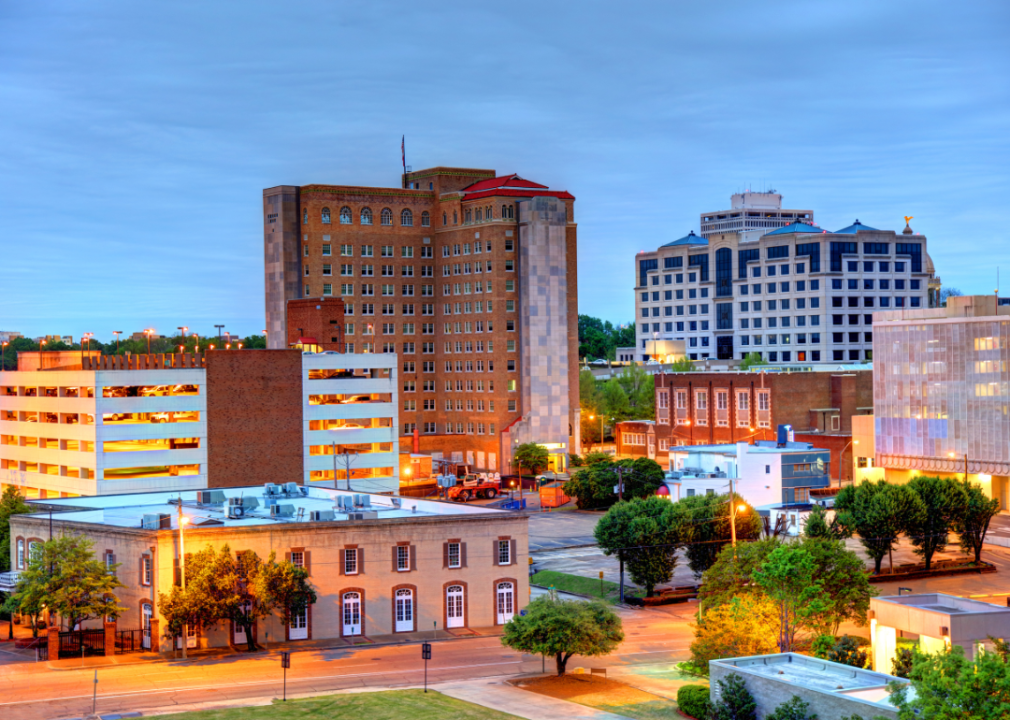
Canva
#5. Mississippi
A parking garage and buildings in downtown Jackson, Mississippi.
– Average cost of living index: 88.3
— Groceries: 96.1
— Health care: 100.7
— Housing: 75.2
— Transportation: 89.7
— Utilities: 90.7
— Other: 93.2
Mississippi is one of the least expensive places in the nation to live. The state gets high marks for housing, transportation, and groceries, and its unemployment rate of 2.8% is one of the best in the country, according to the Bureau of Labor Statistics. But its relatively high health care costs point to other concerning metrics, including a 19.1% poverty rate, per the Census Bureau.
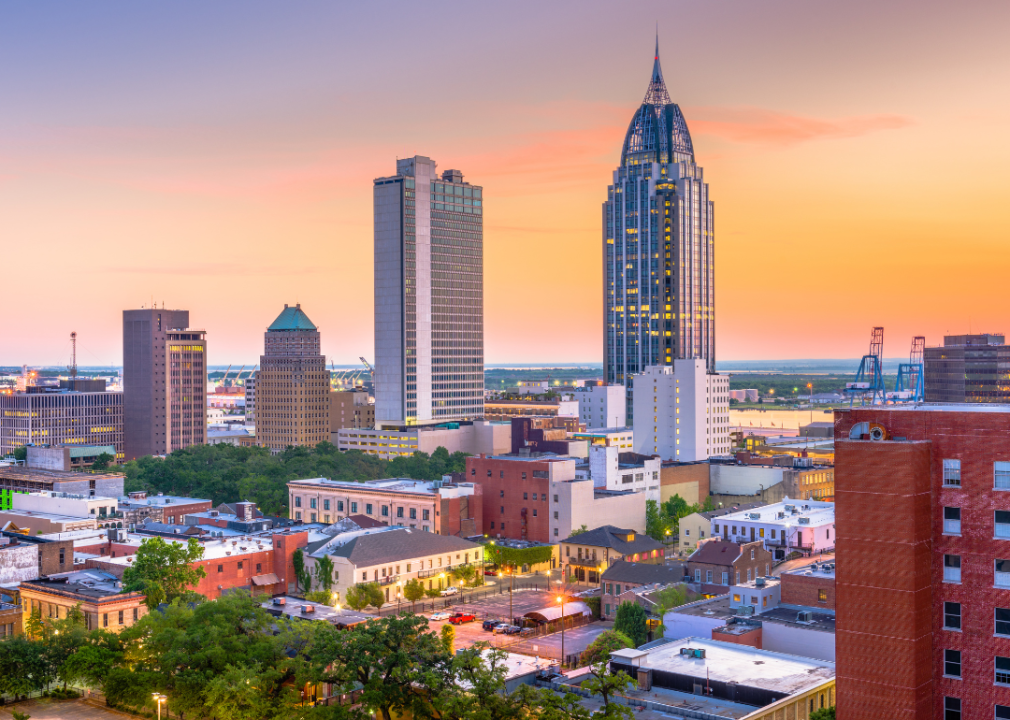
Canva
#4. Alabama
The Mobile, Alabama, skyline as seen at dusk.
– Average cost of living index: 88.1
— Groceries: 97.1
— Health care: 87.2
— Housing: 69.4
— Transportation: 91.2
— Utilities: 100.7
— Other: 95.6
Alabama is #1 for affordable health care in the nation, per the C2ER data. Housing is also inexpensive, with the median home valued at $179,400, according to the Census Bureau. The state has some of the lowest gas prices in the nation, according to AAA, though the cost of energy (largely due to big swings in weather patterns) likely kept it from landing higher in the ranking.
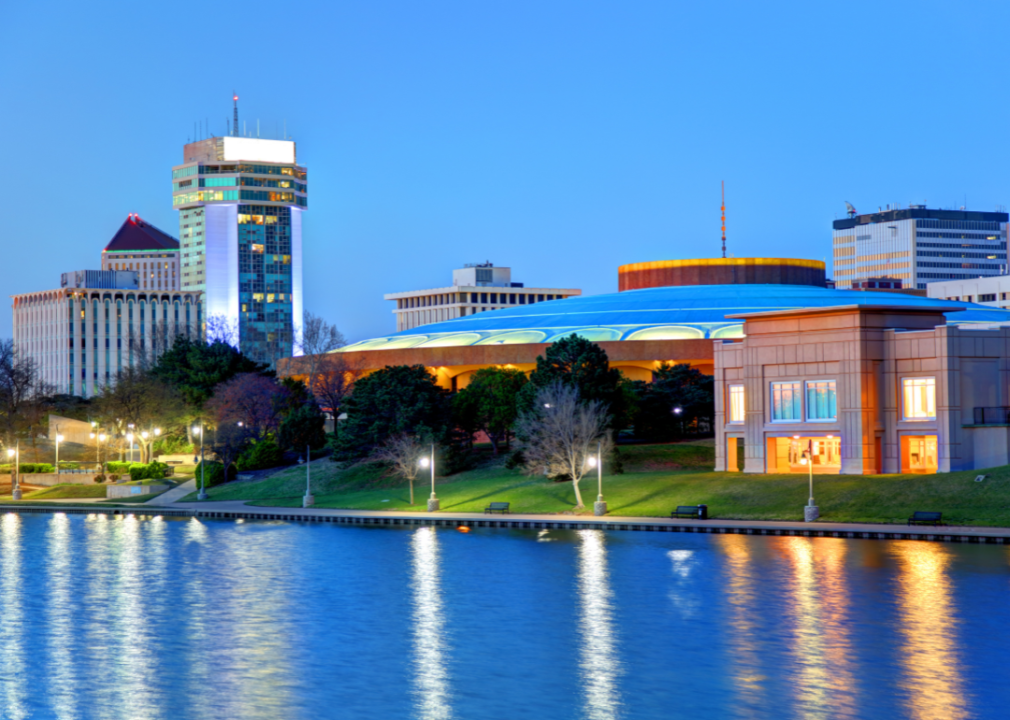
Canva
#3. Kansas
A night view of buildings along a river in Wichita, Kansas.
– Average cost of living index: 87.3
— Groceries: 95.6
— Health care: 98.6
— Housing: 74.5
— Transportation: 87.2
— Utilities: 96.2
— Other: 90.5
Aside from health care and utilities, Kansas ranks no lower than #5 nationwide for the remainder of the above metrics. It is #1 in the miscellaneous category—which includes dining out and entertainment expenses—and #2 in transportation costs behind neighboring Missouri. The Sunflower State is also home to Pittsburg, the fourth-most affordable urban area in the country, according to C2ER.
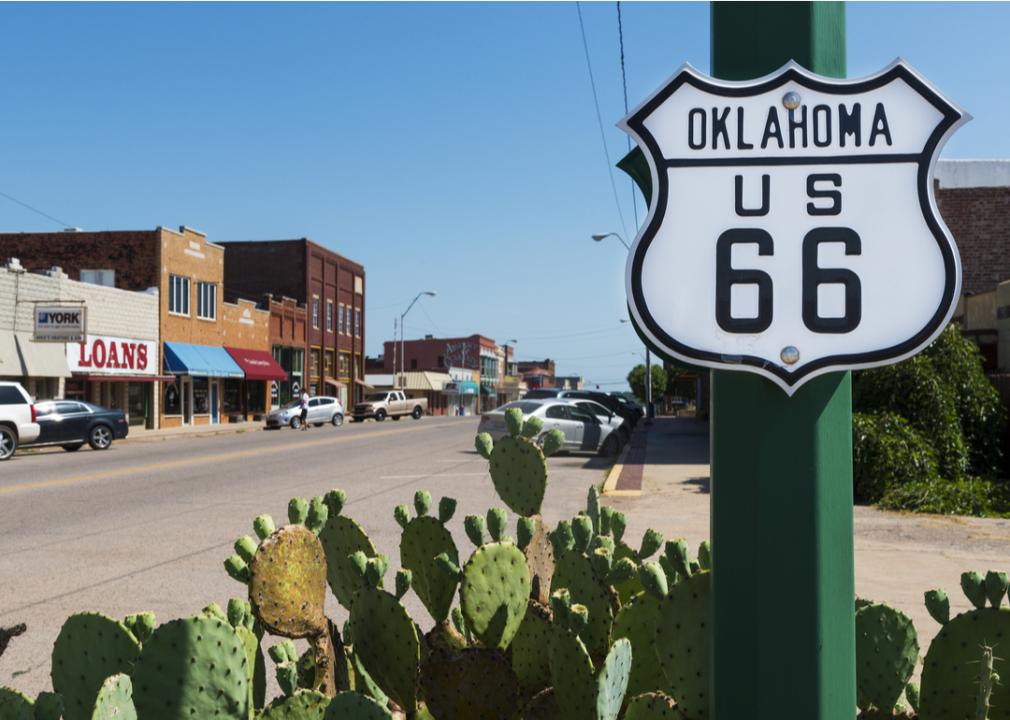
TLF Images // Shutterstock
#2. Oklahoma
Buildings along U.S. Route 66 in Oklahoma.
– Average cost of living index: 86.4
— Groceries: 95.4
— Health care: 95.2
— Housing: 68.9
— Transportation: 89.3
— Utilities: 97.3
— Other: 92
Oklahoma’s housing, groceries, and other costs landed it the #2 spot on this list. The state is one of the nation’s top natural gas and crude oil producers, and it gets 42% of its energy from renewable wind power, according to the EIA. Two of its cities—Ponca City and Oklahoma City—appear on C2ER’s list of the top 10 least expensive urban areas.
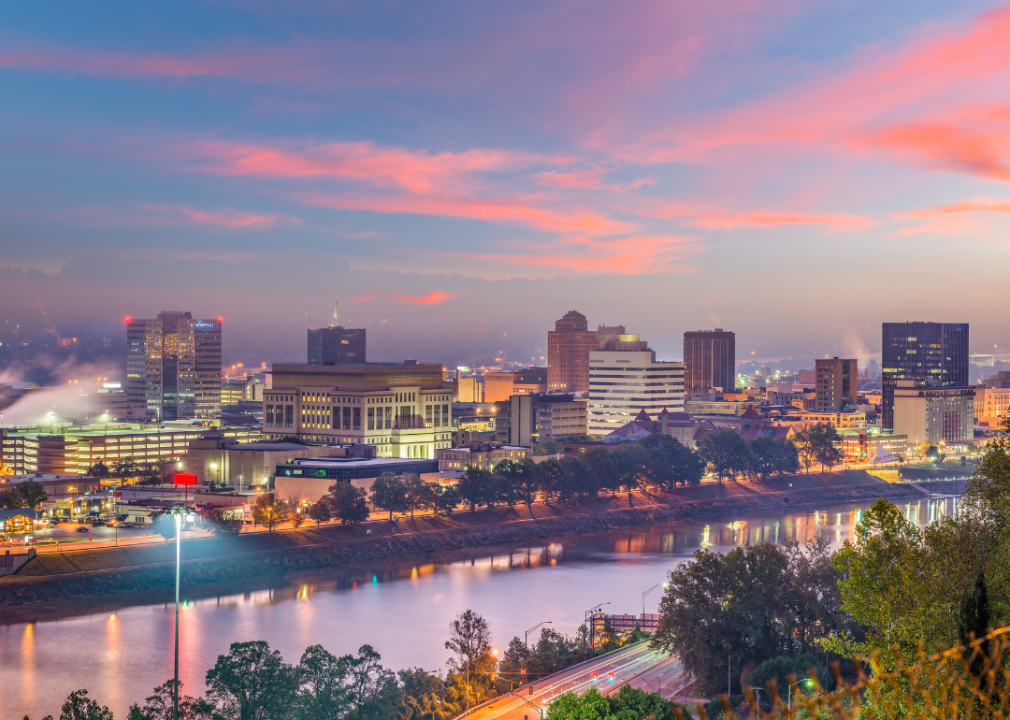
Canva
#1. West Virginia
An aerial view of downtown Charleston, West Virginia, at sunset.
– Average cost of living index: 83.8
— Groceries: 99.6
— Health care: 101.3
— Housing: 57.4
— Transportation: 92.8
— Utilities: 94.5
— Other: 90.9
West Virginia has by far the lowest housing costs of any U.S. state—it bested Oklahoma’s index by 11.5 percentage points thanks to its 74.2% rate of home ownership, $1,180 average mortgage, and $831 median rent, per the Census Bureau. Its grocery costs and health care spending are on the higher end of the spectrum, but its #2 ranking on all other miscellaneous expenditures pushed it to #1 overall.
Additional writing and story editing by Mike Taylor. Copy editing by Meg Shields. Photo selection by Ania Antecka.
You may also like: 11 ways to secure startup funding for your business